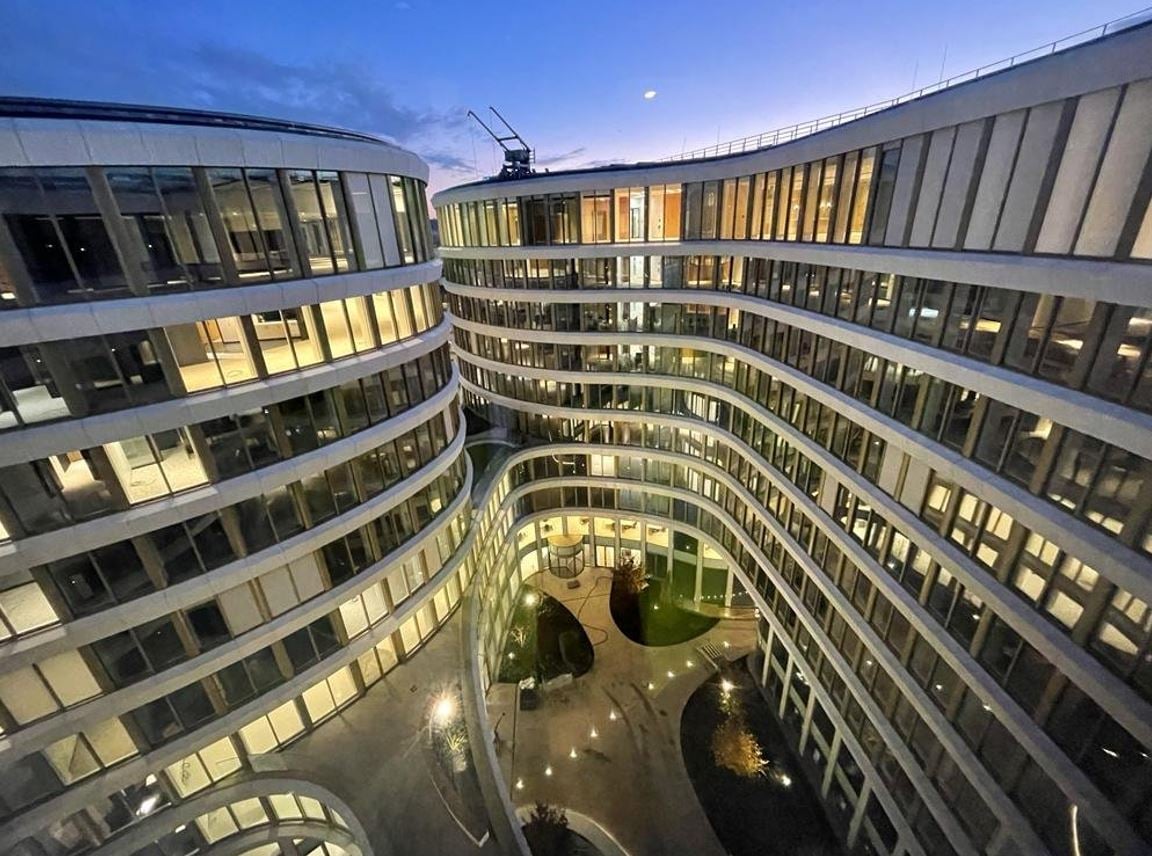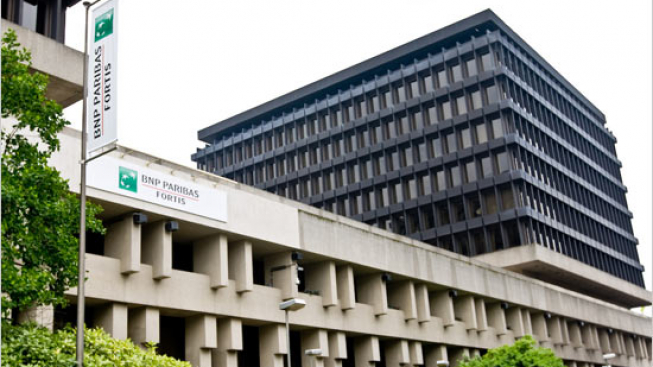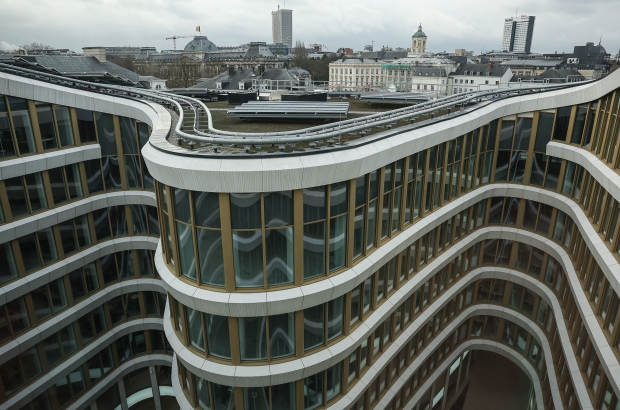- Daily & Weekly newsletters
- Buy & download The Bulletin
- Comment on our articles
Awarding of prestigious prize reignites criticism of new BNP Paribas headquarters
At the Cannes international real estate fair (Mipim), the architects of BNP Paribas Fortis' new headquarters in Brussels - situated between Montagne du Parc, Rue Ravenstein and Rue Baron Horta - received the award for the best business centre.
The prestigious award was given to Austrian architectural firm Baumschlager Eberle Architekten in collaboration with Belgium’s Styfhals and Jaspers-Eyers Architects for their 103,000m2 building, consisting of 12 floors, including five in the basement, which wowed the jury with its bright and sustainable design, ‘green’ roof, energy storage system and photovoltaic panels.

"We no longer need fossil fuels,” explained Max Jadot, CEO of BNP Paribas Fortis, at the official inauguration of the headquarters on 4 February, reports RTBF. “Our energy needs are now seven times lower than in our previous headquarters, which had the same surface area. The space invites you to come and work in Brussels."
Award sparks criticism
Despite its environmental benefits, however, not everyone agrees with the accolades lavished upon the building.
Heritage lovers in the Belgian capital have been vociferous in their criticism of the design. The oft-used term "Bruxellisation" has been mentioned once again – a concept born from the urban madness of the 60s and 70s that led to the destruction of whole sections of remarkable buildings in Brussels in favour of architectural monstrosities. Some have labelled the white-slatted building in the Central Station district as “The Giant Radiator” and have called it “too massive, too modern, too out of step".
The criticism has been growing on social media. Henri Simons, former alderman of urban planning of the City of Brussels from 1995 to 2006, expressed his thoughts in a Facebook post.
"Architectural failure. Awful techniques on the roof. It crushes the Palace of Fine Arts," he wrote under a photo of the new building next to the Victor Horta-designed Bozar. Beneath the post is a roll-call of prominent names, from former and current politicians to local rappers, all submitting similar comments. Even Thierry Wauters, the heritage director at Urban.brussels, the Brussels administration of urban planning, joined the criticism, calling the building’s roof in particular “a real slap in the face in the urban landscape".
Why no objections at the planning stage?
If the building is now prompting so much anger, why did it reach completion in the first place? Surely there had been chances to oppose the design in the years where the plans were submitted and scrutinised?
When Olivier Bastin became the very first master architect of the Brussels Region in 2009, it was agreed that this position would support the regional government "in its role as an exemplary project owner and to promote an architectural culture through competitions, prizes and pilot projects".
Among these competitions was the one concerning the future new headquarters of BNP Paribas Fortis, announced in 2012. Two years later, the jury on which sat Olivier Bastin and the Brussels alderman of urban planning Geoffroy Coomans de Brachene, decided to entrust the Austrian architectural firm Baumschlager Eberle with the task of building it.

For this vision to be realised, it was first necessary to demolish the previous grey and extremely energy-consuming headquarters, which dated from the 60s and 70s, despite some opposition from some who wanted to preserve it as a "symbol of the modernity of yesteryear".
At the time, Olivier Bastin insisted that the new BNP Paribas Fortis building should not be seen as "the replacement of modernism by a form of post-modernism." He also added that a consultation had been organised with neighbours such as Bozar on the construction of new headquarters.
The dismantling of the old building began as soon as the planning permit for its replacement was obtained in January 2016, but there were soon rumblings of discontent.
The magazine "A + Architecture in Belgium", which aims to be the reference in terms of architecture and urban planning in Belgium, wrote in 2018 about the BNP Paribas Fortis plans and in particular the association between Baumschlager Eberle and the Belgian office Jaspers-Eyers Architects, which had already shaped several office districts in the capital, including the Proximus towers, and the Finance, Dexia, and Beobank buildings. The article spoke of a "monopoly" and complained of an "absence of meaning" in the new Fortis project.
But despite misgivings from certain quarters, the project was completed as planned. Now all the critics can do is stand, stare and complain in the face of the white concrete behemoth.
"It is certainly two levels too high compared to Bozar," said one heritage expert in the Brussels Region, preferring anonymity. "Objectively, it is a beautiful architectural object but has not been thought out with its landscape. In fact, it is an architectural object and not a landscape object ... The quality of the façade is imperceptible as soon as you put the building back in its street, its environment ..."
Criticism "typical Belgian reaction"
Belgian Serge Fautré, CEO of the developer AG Real Estate, was one of the jury members who awarded the building its Cannes prize this month. When asked by RTBF why the award was given, he said that the deliberations of the jury were confidential. But he did say that the criticism that is appearing now is a typically Belgian reaction and one that says much about the nature of social networks.
“All these criticisms are something extraordinarily Belgian: to see a Belgian project be crowned with a prestigious prize and then some people complain about it on social networks rather than rejoice," he said. "Social networks more often express discontent than carry positive messages. I imagine that there are many people out there who do not speak and who rejoice in this award."
Fautré emphasised that the Mipim prize, "is not an architecture prize. That is another matter. The people who voted focused on many aspects other than the façade and what is on the roof. The Mipim award tries to express, as is often the case, the societal impact that a project can have on the city, region or neighbourhood in which it is located."
Fortis HQ was chosen in the "Best Business Centre" category, because it offers its owners and the 4,100 employees on site "increased worker satisfaction and productivity, better well-being, greater flexibility and better energy and environmental performance of the workplace".
"Without revealing the deliberations of the jury, it's the quality of the work environment offered to BNP Paribas Fortis employees that made the difference," added Fautré. "This is all the more important at the end of the pandemic and the need to find human workplaces, which promotes the sharing of projects and meaning."
The accusation of modern Bruxellisation doesn’t sit well with Fautré. “To speak of ‘Bruxellisation’ is just to use words, but that is not the reality here. I would remind you that there was an architectural competition, a public inquiry, consultation commissions... Everyone had the opportunity to give their opinion on this project... Today, the building, it is there. Let us be delighted to see that a company the size of BNP Paribas invests money for a headquarters and thus perpetuates its presence in Belgium."
Greenwashing used to justify demolition-reconstruction says ARAU
At ARAU, the Urban Research and Action Workshop, Marion Alecian, its director, believes that the project is totally open to criticism in three aspects.
First, on "the issue of demolition-reconstruction and greenwashing that is used to enable this demolition-reconstruction,” she said. “There is also the question of the insertion of this project in the landscape in the historic centre and in front of the Palace of Fine Arts. Finally, it is necessary to raise the gap between a prize awarded by experts and the support of real estate professionals and the other, the vision of the inhabitant who must say that this building is worse than the one before."
"This BNP Paribas Fortis project is based on a complete demolition-reconstruction," says Marion Alecian. "This project is presented as more urban, better inscribed in the landscape and condemned the two towers that were frankly not appreciated by the people of Brussels and without heritage interest. At the time of the public inquiry, there were few rejections of this project because no one had an affection for the building to be demolished. However, today, we observe that there is a tension around this new headquarters, a legitimate tension."
"There is a kind of curtain, a new wall erected in the street that is very different from the heritage that surrounds it, among others the Palace of Fine Arts designed by Horta. There is something that shouts and stands out. It's quite aggressive, much more so than the previous building it replaces."
White wall "explodes" in the street
"We were promised," added Marion Alecian, "a building with a certain fluidity and transparency. Then, finally when we walk along the street, already from the Mont des Arts, we see something that completely explodes with this white wall, which is quite high, even if it is lower than the previous one. There is a difference between what had been announced and what has been built."
"We had a lot of questions about the perspective with Bozar,” she continued. “Even the authorities are asking themselves the same questions and wondering how we got here. The permit was still issued and went through these same administrations. It remains surprising that the project receives an award for its different environmental and urban qualities even though it is currently decried by residents, administrations and associations."
"There is now a reflection that aims to measure the pros and cons, between the current situation and the projected situation with the criterion of the link from a demolition-reconstruction with a view to a better contact with the city, the nearby buildings, the inhabitants. Here, what is quite shocking when you see the new headquarters is that it's difficult to see the link that is created with the city when you are facing this facade. It is a curtain without contact with the outside."
Why, then, did those critics not mobilise and petition during the public inquiry? Why wait until its completion and then air their criticisms out in the open?
"Despite all that we can find as defects, there was a public inquiry, we could express ourselves," admitted Alecian. "This is where the big gap in the current public inquiries lies. The project has not been transparent. Many only discovered the impact on the street once the project came out of the ground. And I think that is also the case at the administration and at the political level."



















